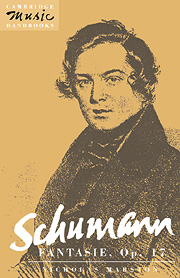Book contents
- Frontmatter
- Contents
- List of plates
- Preface
- Acknowledgements
- List of abbreviations
- 1 The compositional history of the Fantasie
- 2 ‘What's in a name?’ Genre and title in the Fantasie
- 3 Allusion and quotation in the Fantasie
- 4 Form in the first movement
- 5 Schlegel's leiser Ton and thematic unity in the Fantasie
- 6 Form in the second and third movements
- 7 The subsequent history of the Fantasie
- Notes
- Bibliography
- Index
- Plate section
1 - The compositional history of the Fantasie
Published online by Cambridge University Press: 26 January 2010
- Frontmatter
- Contents
- List of plates
- Preface
- Acknowledgements
- List of abbreviations
- 1 The compositional history of the Fantasie
- 2 ‘What's in a name?’ Genre and title in the Fantasie
- 3 Allusion and quotation in the Fantasie
- 4 Form in the first movement
- 5 Schlegel's leiser Ton and thematic unity in the Fantasie
- 6 Form in the second and third movements
- 7 The subsequent history of the Fantasie
- Notes
- Bibliography
- Index
- Plate section
Summary
Between 10 and 13 August 1845 the town of Bonn was en fête. The reason for the festivities was the unveiling of the Beethoven monument or Denkmal on the Miinsterplatz. Among those present were Queen Victoria and Prince Albert, and the King and Queen of Prussia. Before the unveiling took place, around midday on 12 August, Beethoven's Mass in C, Op. 86 was sung at a service in the Munsterkirche. At four o'clock there was the second of two concerts directed by Liszt and Spohr, both of whom had played a major role in the monument project. Among the works performed were the ‘Emperor’ Concerto, conducted by Spohr with Liszt as soloist; the Fifth Symphony; the ‘Harp’ Quartet; and numerous other pieces, including excerpts from Christus am Oelberge and Fidelio. One reviewer estimated that the audience numbered some three thousand people, all crammed into a concert hall about two hundred feet in length. Quite apart from the considerable discomfort which the audience must have suffered, they also forfeited the opportunity to witness one of the more visually imposing events of this Beethoven-Fest, the illumination of the Rhine at Cologne.
Robert and Clara Schumann planned to attend the celebrations. Schumann's diary records that they left their home in Dresden on 31 July and reached Leipzig that evening. Early the following morning Schumann wrote to Liszt telling him that he would be present in Bonn. But he suddenly became ill, and on 2 August he decided to alter his plans.
- Type
- Chapter
- Information
- Schumann: Fantasie, Op. 17 , pp. 1 - 22Publisher: Cambridge University PressPrint publication year: 1992



